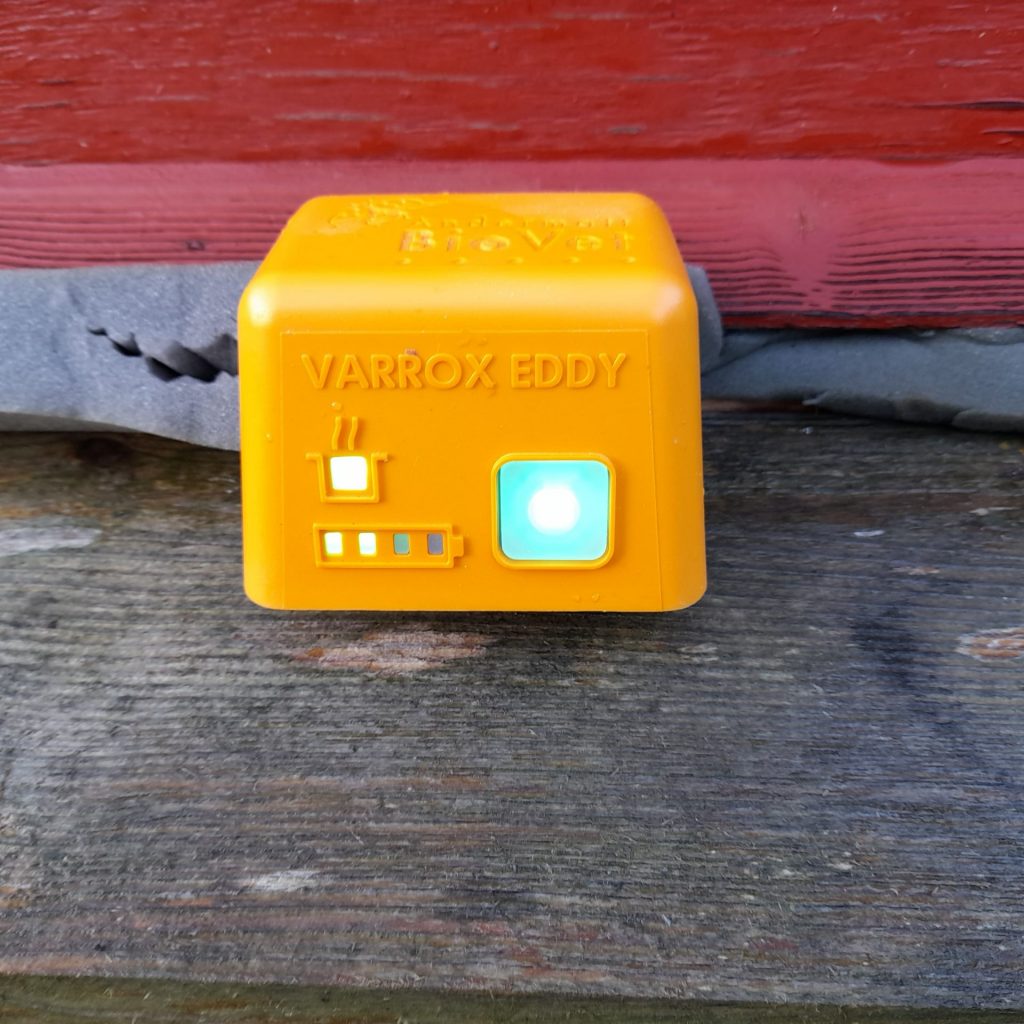
Storm Barra hasn’t reached us yet and another calm day is on the cards so I’ll be off out soon to do another round of apiaries and help some beekeepers get the oxalic acid treatments done before the Solstice in 11 days time. The queens will start laying again after that.
It’s my least favourite job because I feel the cold and my fingers usually go white at the ends after just a few minutes in the apiary hanging around while the colonies are treated using the varrox wand and battery, or the gasvap systems. My feet feel cold in wellies even when I’m wearing my New Zealand possum fur and merino socks!
Last year, vapourising at Cynthia’s distillery apiary was a nightmare because the Gasvap gadgetry fell apart at the crucial moment, and it was nigh on impossible to complete the task without burning fingers and risking clouds of vapour swirling about. I was wearing the protective mask, goggles and gloves but it’s best to be completely clear of vapour in my opinion. Apparently the newer Gasvap models have a screw which keeps the crucial parts together and lots of people get on well with it. Not me! When the flame torch needs refilling with butane lighter fuel on a cold day with numbed fumbling fingers, I can hardly make that work either so, no more of that nonsense. No more lugging a battery about either for the Varrox system because Eddy comes in a neat box with a handle.
Varrox Eddy.
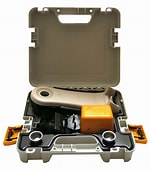
https://www.andermattgarden.co.uk/bee-health/varrox-eddy-oxalic-acid-dihydrate-battery-vaporiser
It’s been a good year and I’ve splashed out on a Varrox Eddy. Yes, it’s costly at £359.99 but worth every penny for me in terms of safety, speed and comfort. The cost will be reduced by charging a small fee for lending it out.
Off With a Smile.
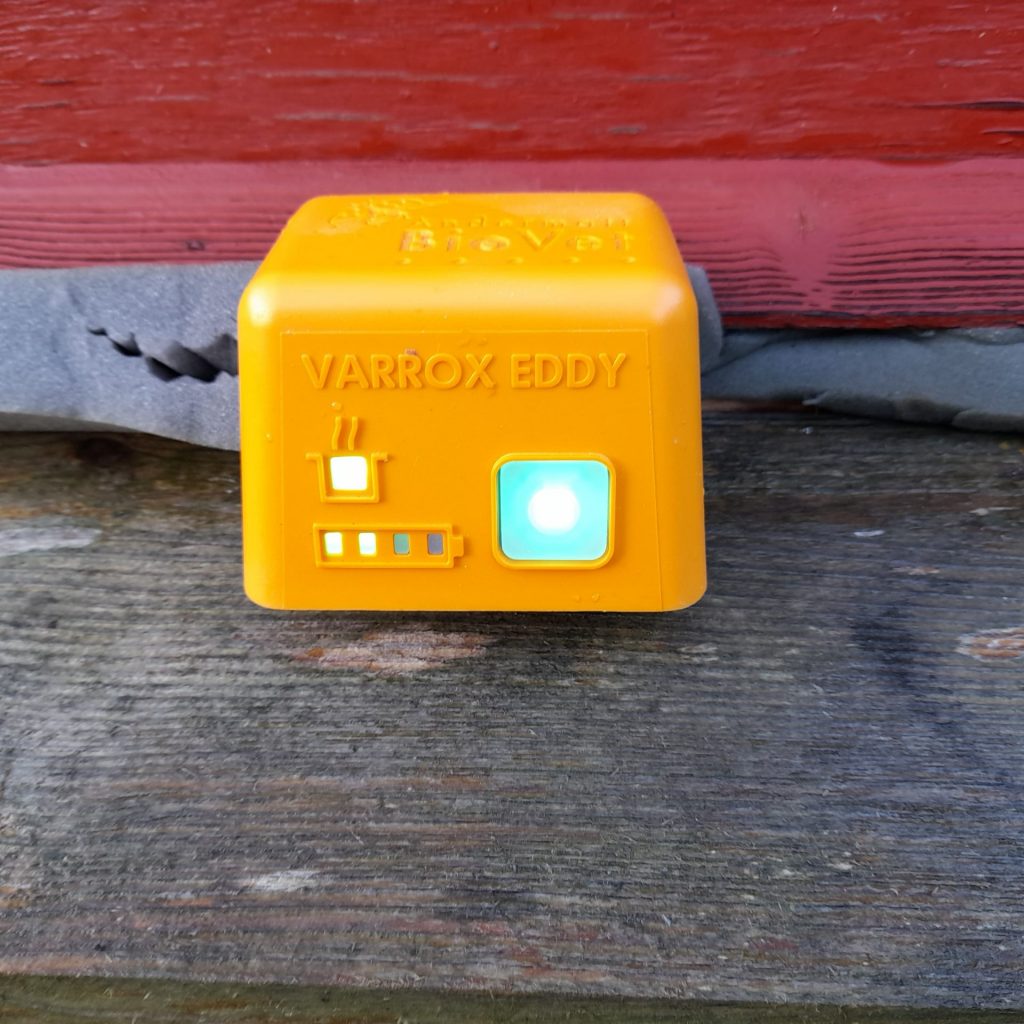

I’m happy now because I know that I just have to press a button to turn Eddy on and walk away as the tool heats to the correct temperature and delivers the vapour. I’m wearing the protective gear but am nowhere near the colony until the treatment is over. Before Eddy starts heating, I place the oxalic acid crystals in the small pan that sits on the end of the wand and slides into the hive entrance. Once in place, I simply press the on button and walk away till the violet light alerts me to the end of treatment. I wait till the green light comes on again because by then the little metal pan has cooled. There is a spare pan and a spoon for measuring out the Apibioxal crystals.
Yesterday, I treated 11 colonies before the battery needed recharging but it was very quick to recharge enough to complete the job on 2 more colonies. You could always carry a spare battery unit if you have a lot of colonies to treat and recharge the other in your truck.
Hive Entrance Height.
Only one word of warning, measure the hive entrance heights before buying one of these if you have to work alone because my Swienty poly hives have a narrow slit entrance, and Eddy is 1.5 cm thick at the working end and doesn’t fit. However, this is where a bee buddy comes in and it is easily managed with one person to llift or lever up the brood box with a hive tool as the other inserts the wand and blocks the entrance with foam packing. I’ve no doubt that some people out there will manage by themselves.
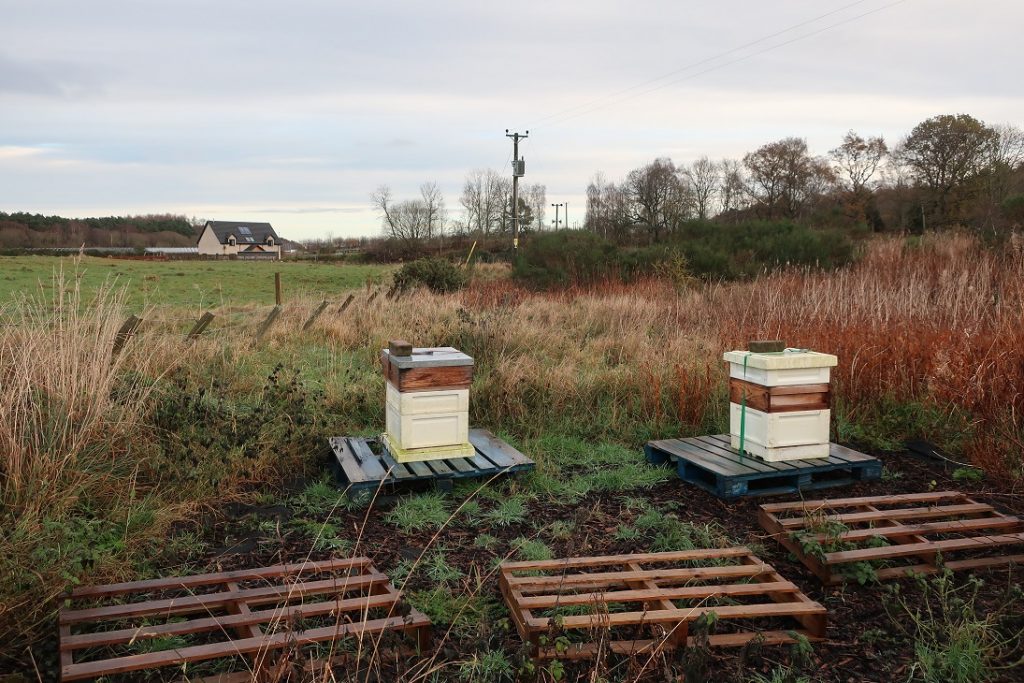
Rick and I work together on his home and out apiaries today and the job is over quickly. As we wait for treatment to complete we stand in sunshine in his secluded apiary close to the main road but invisible to passing traffic. Three police cars pass with flashing blue lights followed by two enormous wide-loaded trucks carrying massive pieces of wind turbine heading south to Aberdeen.
After that I go on to Cynthia’s town apiary, then to the distillery. We enjoy bacon butties (bacon in soft white Scottish morning rolls) with a good cup of strong tea and marvel at how painless the treatments were this year.
Book Reviews: How to Manipulate colonies for More Honey
I wrote these reviews for Northern Bee Books and found that the books made interesting reading though manipulating colonies to produce more honey is not something that I’m interested in because I keep things very simple here.
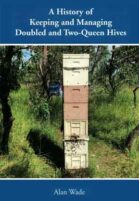
Title: A history of keeping and Managing Doubled and Two-Queen Hives.
Author: Alan Wade.
Published: 2021 by Northern Bee Books, West Yorkshire, England.
ISBN 978-1-914934-162.
154 pages.
Cost: £19.95.
Although the main purpose of this book is to explain a system of manipulating honey bee colonies to produce more honey, it achieves much more than this. Painstaking research by the author charts the history of doubled and two-queened hives from their invention 140 years ago to the present day. Wade compares the way beekeepers adapted and used these systems over the years while explaining the advantages and disadvantages of each variation. Excerpts from past literature contribute to the sense of history giving us valuable insight into beekeeping from the past.
A table of contents enables easy navigation of the book which is divided into 2 parts. Part one deals with double-hive beekeeping in 4 chapters, while part two describes two-queen beekeeping in 6 chapters.
You will find a useful appendix and an extensive bibliography which includes 236 references. The explanatory text is augmented by the extensive use of elucidating diagrams and photographs.
The author is an experienced beekeeper and scientist living in Australia where he has had great success with the systems that he describes. It is worth noting, however, that Varroa destructor has not yet been discovered in Australia. Interestingly though, recent experiments in the USA, where varroa is endemic, have demonstrated how two-queen colonies have produced more honey than any other in one club apiary.
In the early chapters, Wade describes how Englishman George Wells invented a double hive system around 1894 when commercial bee farming was in its infancy. This method consisted of two brood boxes sitting side by side and separated down the middle by a queen excluder keeping apart the queens in each box, but the workers united. The honey supers sat in the middle above the brood boxes.
Ten years later in the USA, E.W. Alexander made a similar discovery and found that one or more queens could be introduced to a queenright colony and this system is also described in great detail. These hives are operated to take advantage of the laying capacity of the additional queen or queens, and they produce a lot more honey than single queen colonies. The combined workforce of two or more laying queens makes honey gathering more efficient than those of two average single queen colonies because less time is needed to tend brood, and the workers are freed up to collect nectar.
Some other advantages of the Well’s system are that colonies over winter will benefit from shared warmth, and there is a spare queen in spring if needed elsewhere in the apiary. It is believed that, despite having strong populous colonies, normal swarming tendency is suppressed by having a second queen because more queen mandibular pheromone is produced.
This book will appeal to the curious academic beekeeper interested in beekeeping history as much as it will to the beekeeper thirsty for more honey. Wade includes enough honey bee life history to help the reader understand why the system works, and he describes, in the last chapter of each part, how one can set up and manage each system effectively today.
It should be noted that the popularity of these strategies waned considerably after only a few decades of use because they are somewhat unwieldy, and not suitable for migratory and commercial beekeeping. Both systems are fairly complicated and require beekeeping experience and physical strength, therefore they might not be easily managed by new beekeepers, or beekeepers working alone.
The principles of these systems may not sit comfortably with those of Darwinian beekeeping but Wade writes honestly. He acknowledges that some beekeepers will be more interested in keeping healthy gentle bees in good nutrition, and providing just enough honey for the table rather than getting the maximum honey return. However, it is possible for beekeepers to keep just a few colonies producing massive amounts of honey, rather than spending more time handling greater numbers of colonies of bees that don’t develop and produce so well.
Certainly, there much to contemplate in this carefully written book.
Checkerboarding.
Swarm Management with Checkerboarding by J. White, A. Hunt, and G. Bannister
Published by Northern Bee Books, First Edition 2021, 32 Pages, Paperback: £9:95
ISBN:978-1-912271-86-3.
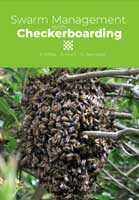
Swarm Management with Checkerboarding is about preventing swarms and producing more honey which will appeal to most beekeepers.
The authors have done a splendid job researching the subject and explaining how this non-invasive swarm prevention technique works. Based on work carried out in the 1990’s by American beekeeper Walt Wright, the team of beekeeping friends from the south of England trialled checkerboarding with five colonies over the 2019-20 season. None of these colonies swarmed that year and their honey harvest was massive.
In contrast with traditional methods of swarm control and swarm prevention involving rearranging and manipulating the brood nest, this method relies on rearranging the honey super frames directly above the brood nest. The arrangement consists of supers with empty frames placed next to full frames. Well executed diagrams and lucid instructions make this technique accessible to all beekeepers.
This method works on the principal of creating nectar storage space above the brood nest and understanding the biology of honey bee swarming. Common to all living things, honey bee colonies have one main objective: to survive and propagate their genes. Colonies pass on their genes by producing queens and drones.
For the parent colony to survive once the swarm has departed it must shrink the brood nest so that there are not too many offspring for the remaining nurse bees to care for. This results in nectar encroachment in the brood nest which is called backfilling and a gives an important clue that the colony is preparing to swarm.
A key trigger for swarm preparation is the solid layer of stores above the brood nest, so disrupting this by checkerboarding can prevent or delay swarming. The innate obduracy of the honey bee and its strong urge to store honey means that the colony continues storing nectar because it doesn’t have that reassuring layer of solid stores above the brood nest, or the urge to swarm.
Like most beekeeping activities, checkerboarding needs to be planned well ahead for success which is why the authors started preparing the colonies in December for the upcoming season. They share with us a suitable timetable for the whole process.
The main advantages of checkerboarding are:
- Prevention or delayed swarming
- An increased hive population
- Larger honey harvests
- No need for invasive swarm control manipulations
- Winter hive preparation without much supplementary feeding if any.
Since climate, weather and beekeeping conditions vary considerably throughout the UK beekeepers in harsher northern climes may need to adapt the timetable to suit their areas. Solid combs of honey help insulate the winter cluster so disrupting this layer may compromise a colony in some climates.
It would have been interesting to learn which crops the trial colonies foraged on, and if this system works well for oil seed rape and canola honey. Since both of these crops granulate quickly when cool, might spacing the honey- filled frames accelerate this process?
Even if you have no immediate plans to try checkerboarding, this book contains gems of valuable information for the curious beekeeper wanting to better understand swarming. It is attractively bound with colourful photographs on front and back covers and I am delighted to have it on my bookshelf.

Started oxalic acid vapour at the end of November. Treatment again last Friday, followed by a 2 day drop test, ending on Wednesday.
The white cappings on the board evidence newly emerged bees this week. The hive was treated in mid August with fluvalinate, and as the queen continued laying, oxalic acid vapour in October was ineffective.
Lesson learned. Repeated oxalic acid may be required in mid winter until varroa is brought to heel. Is this your experience?
Good morning, David. Oxalic acid vapourisation is done with some efficacy during a broodless period, though I know that some beekeepers treat every 7 days for a brood cycle (3 times) during spring/summer. Oxalic acid trickle method is only done once a year during the broodless period as it does harm brood. I think that the key is monitoring varroa levels and the sugar roll/ alcohol tests performed several times during the season gives a more accurate picture than monitoring the drop on the floor. However, monitoring the drop and using the BeeBase calculator is useful too. Do your use this calculator to help you work out when and how to treat? Are you registered on BeeBase? What was the varroa drop after Fluvalinate? Was it effective? How long have you been using this treatment? Varroa become resistant to these “heavy duty” chemicals. If Fluvalinate was successful then a once only oxalic acid vapourisation/sublimation is all that is needed.
No, I don’t do repeated oxalic treatments over winter. Only once in early/mid December. Best wishes, Ann.
Reside in Northern Ireland, hence unable to register on BeeBase (why?), but I do find the calculator very useful. Drop rate during October around 25, 50 at the end of November.
Used apistan for the first time on 2 hives this year, a third swarm hive was treated with maqs.
The second apistan hive went into a prolonged brood break of about 6 weeks, which may explain why apistan appeared successful.
Apilife Var used at association Apiary was much more successful: I don’t plan to use apistan again due to documented resistance.
Interesting comments on trickle oxalic. Will look again at how I use the gasvap. Thanks Ann. Most helpful.
Hello, David. Great that you can access BeeBase and use the varroa calculator but I am surprised that you cannot register. Do you have bee inspectors in NI? At the moment the purpose of registering is so that we can be told if/when there is a foulbrood outbreak near our apiaries, so apiaries are registered rather than beekeepers. Oh and we now have to report varroa as of this year. I will make some enquiries to see what I can learn about this.
Interesting to hear about the prolonged brood break.
You probably have a newer version of the Gasvap with the screw to keep things together. I found the torch flimsy. It was designed to be available to every beekeeper at a relatively low cost but you probably have to be more skilfull to use it. I’m confident about lending out Eddy because there is no risk of harm to users.
Thanks so much Ann for your help!
You’re welcome, Rick. All part of the service.
Yes, you are right, Ann – once is fine. Any brood at this time of year is sacrifical and is there to regulate temperature and humidity, not to produce new bees that would emerge with mites. It is lovely to read your accounts of the pitfalls and advantages with using different equipment. xx
Thank you for the positive comments, Margaret.
It was truly stress-free Ann. No faffing about with broken equipment, (last year’s fiasco was traumatic!) and it was all over very quickly, hence time for the butty! Thanks, as always, for your help.
Thanks for commenting, Cynthia. I can hardly believe it’s all over for another year!
Thanks Ann I have put the two books on my Christmas list ! As we do get a lot of oil seed rape round these parts , oxalic acid , well when I get back into the bees , well that’s something else ! Chris
All the best, Chris. I hope you enjoy the books and are able to use some of the information.